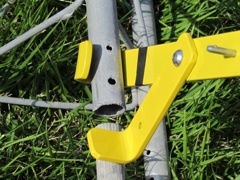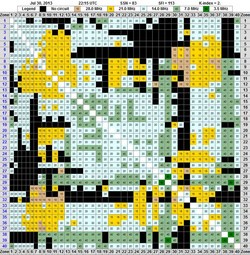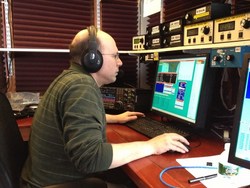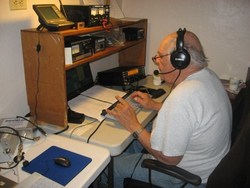 July 31, 2013 Editor: Ward Silver, NØAX | |||||||
IN THIS ISSUE
NEW HF OPERATORS - THINGS TO DO Technicians are encouraged to give their 10 meter phone privileges a try in the 10-10 Summer Phone QSO Party. The 10-10 events are great ways to get started with low-key contesting! If you missed out on Flight of the Bumblebees last weekend, you can swat a few more QRP signals in the New Jersey QRP Club's Skeeter Hunt! BULLETINS There are no bulletins in this issue. BUSTED QSOS Completely missing the March 2013 cutoff, I reported that NAQP and Sprint contests were coming up for WRTC2014 qualification, prompting Larry K4AB to write in and say, "Au contraire, mon frère - the hay is already in the barn!" CONTEST SUMMARY Complete information for all contests follows the Conversation section Aug 3-4
Aug 10-11
Tom K8CX continues to post really interesting ham radio history. The latest, a story on XV5AC, covers a famous operation during a turbulent and exciting period of DXing. There are a lot of stories to enjoy and imagine here. Tom's website is jam-packed with good stuff! If you need a presentation on getting into contesting, Kirk K4RO provides links to a couple; one by Rick N6XI and another presentation he put together himself. Sharing our good ideas keeps the doors to contesting wide open for newcomers.
The handy tower-wrangling tool known as the Towerjack hasn't been available lately but there is a new version. Hector XE2K and Jim KØXU have discovered the Yellowjack from KF7P Metal Werks. True to the name, it is in fact, bright yellow and looks to be a pretty capable replacement for the Towerjack. Word comes via the K9YA Telegraph of Ham QTH, a new online service by Petr OK2CQR. It combines a call sign database, propagation prediction, mapping services, forums, and so forth. Petr is building a comprehensive set of developer interfaces, as well. A contester can sure change the band switch in a hurry when a needed multiplier pops up on the bandmap but I don't think they can do it as fast as these scientists do - a trillionth of a second? Is that shorter than a bazillionth? (Thanks, Tim K3HX) Scott K7ZO recently redeemed some IRCs for "Global Forever" stamps and passes along this helpful hint in case your local postal clerk encounters difficulty working with the computer system to process this admittedly unfamiliar item. "Where they got hung up, and this is a tip to all in case you run into this, is that somewhere in the redemption process the system asks for "Sale by item number". My team was entering the IRC item number when they should have been using the Air Mail stamp item number, which is 578800." Texas Instruments has just released the CC1200, a receiver-on-a-chip designed for use in VHF and UHF ranges used by amateurs. True, it's not going to make anybody forget their high-performance communications-quality receiver but for various short-range projects, it might be just the right part!
The propagation prediction software ZoneProp produces a 40 zone by 40 zone matrix that is updated hourly at approximately 20 minutes past the hour. The intersection between a row and column gives the band on which a contestant in the zone represented by the row is mostly likely able to contact a contestant in the zone represented by the column. Note that the model on which ZoneProp is built (known as REC533) is intended for long-term averages - don't expect it to reflect short-term changes in conditions. That's what your brain is for! (Thanks, Syl VE5ZX, Rick ZL2HAM, and Dave AB7E) Web Site of the Week - We'll all miss the Voodoo Contest Group as the Voo-Dudes hit the airwaves at 0000Z on those last full weekends in November but there is a new website chronicling the adventures of said Dudes, developed by John G4IRN. All 19 years of the group's travels, travails, and triumphs are there, including video clips and interesting tidbits about life in West Africa. (Thanks, Roger G3SXW and Jim N7US) WORD TO THE WISE Bip/Bop - I just love the sound of this term that describes a hardware switching arrangement for stacked Yagis with either both in phase (BIP) or both out of phase (BOP). Why would you drive the antennas out of phase? By creating high-angle lobes in the radiation pattern - usually undesired - signals coming in at those high angles, such as short skip or certain DX paths, can be heard and worked with ease. What's radiating those big signals from W3LPL? Bob K8IA provided this link to the Baltimore Amateur Radio Club's photo album of the station. The Potomac Valley Radio Club website contains this set of photos taken by N3CW during contests in 1969 and 1970 at the legendary W3MSK/W3AU station. (Thanks, Ray NM2O and Tim K3LR) After the 2013 Dayton Hamvention, several hams, including videographer Randy K7AGE, went on a tour of the historic WLW 500 kW transmitter. The tour was conducted by Jay K8CJY and Geoff W8GNM - both recent retirees from Harris Broadcast division. (Thanks, Mike W9RE) Yep, yep, yep, yep, yep, yep...radio! (Thanks, Jack WAØRJY) Online certificates are now available for CQ WW DX Contest of 2012 and later. All entrants may download a certificate as Adobe PDF files and print it on their own computer. (Thanks, CQ WW DX Contest Director, Randy K5ZD)
The extended version of the 2013 ARRL DX Phone article will be online in a day or so - final details and the set of regional writeups are being completed. Watch the ARRL Contest Branch website! WA4ZXV, the GA QSO Party director, has announced that the results and plaque winners have been posted from the 2013 GQP held in April. (Thanks, John K4BAI) The official results of the WRTC Station Test for 2013 have been released. It was a photo finish between team W1UE (+W1KM) and team N2NT (+N2NC). The logs of all competitors, photos of the sites, and more details are available, as well. The WRTC2014 Organizing Committee especially wishes to extend special thanks to all of the volunteers who did the setup/operating/take-down work. Claimed Scores for the 2013 - CQMM DX Contest are published. The final results will be released August 20, both online and in the Portuguese version of CQ Magazine. (Thanks, Luc PY8AZT) Marshall K5QE sends a final report on the extremely rare EL84 grid DXpedition. "We logged 1401 QSOs on 6M with only a few dupes. Several of our group have wondered if a VHF Grid DXpedition has ever made 1400+ QSOs before?? All of us think that we were able to grab the brass ring on this one. Our previous DXpeditions worked 300-400 QSOs, so this one is really special for us."
OPERATING TIP Call CQ Where You Can Be Heard - This sounds pretty simple but it's advice often forgotten in the heat of battle. If your station is not a Monster of the Midway you need to be sure your signal won't be buried in noise and QRM at the receiving stations. Even if you do find what sounds like a "clear" frequency on the low end of 20, is it likely to be a clear frequency in, say, Eastern Europe? If you are a 100-watts-and-tribander station, calling CQ here might work but more likely you won't be able to hold the frequency. My advice is to go ahead and try but be prepared to find something higher in the band where the "other" stations can hear you more clearly. An oldie-but-goodie from Jim K9YC for using 75-ohm cable to feed a 50-ohm load: make the 75-ohm line an integer multiple of half-wavelengths at the operating frequency. (This only works at frequencies for which the half-wavelength requirement is satisfied.) To calculate the length, use the velocity factor of the line, cut it a little long, then trim until it's right. Trimming the length is easy - put a connector on one end, short the far end, and measure the impedance using any antenna analyzer. At the half-wavelength length, it will measure as a short (R + jX = 0 + j0). SWR will be infinity at all frequencies due to the short. Jim has also published the slides from his 2012 Pacificon presentation on using the Smith chart with data from a Vector Network Analyzer to perform impedance matching. Jim has used these techniques to replace costly antenna tuners with switched transmission line stubs. Magazine Roundup
Here's another take on portable stations - the inflatable emergency airborne comm network. This poses an interesting situation for VHF+ contesters. Why not place the antennas and radios in a balloon way up in the air and link to them from the ground? (Thanks, Brian Fernandez) Doug NH6ZA spotted this item from Science Daily about a new form of solar cell that combines a photoelectric function with a metal oxide to generate hydrogen directly from water. There are many technologies and sciences previously unrelated that are now converging to make advances in areas like direct utilization of solar energy. (Thanks, Doug NH6ZA) What's old is new, as described in this online blog about "Pi Networks and Dipping the Final". (Thanks, Jerry WAØACF) Tom Milligan writes the Antenna Designer's Notebook column for the IEEE Antennas and Propagation Magazine and also maintains a companion website. There are lots and lots of links to various antenna-related topics of interest to the technically-minded. Tower veteran Pat N9RV provides three simple rules for dealing with tower legs that don't quite mate properly:
John KK9A also suggests a long steel bar that fits inside the leg or a pipe that fits over the outside would be another option.
If you have a problem with an antenna-support rope abrading where it crosses a tree limb, try taking the outer sheath off a few feet of large diameter coax and slipping it over the rope at the trouble point. Use tape to hold the sheath on the rope. Your editor notes that ropes should be limited to holding up wire antenans. (Thanks, Art KB3FJO) Bill N3RR is publishing an ongoing account of his conversion from a one-radio contester to SO2R (Single-Op, Two Radios). You may find the discussion if you are wrestling with similar issues or contemplating such an upgrade to your own station. Technical Web Site of the Week - David K3KY has written and published a series of pages about some aspects of the care and feeding of antennas that are fed at high-voltage points, such as the Bobtail Curtain. The three-part series consists of an overview, discussion of grounds, and a bibliography. He also recommends using the "Improved Single Coil Z-Match" as described in the ARRL Antenna Compendium, Volume 5, page 194. Squigglies As we proceed ever-closer to the back side of Solar Cycle 24, if we're not there already, we can expect some heightened solar storminess if past cycles are indicative of what lies ahead. After a recent minor CME impacted the Earth's geomagnetic field, Steve AA5TB recorded what he characterized as a "squiggly" on 20 meters. Paul NA5N is a radio astronomer at the Very Large Array in New Mexico and was quick to respond on the QRP-L email reflector, both with a confirmation and some background on these interesting occurrences. I thought it might be of interest to Contest Update readers - enjoy! 73, Ward NØAX Congratulations!!!! You successfully recorded a normally elusive Type III solar storm, also called a "Type III Sweep." It is related to real-time solar activity, not geomagnetic activity triggered by a CME shock wave that left the sun 2-3 days ago. There were several C-class flares on July 8-9 UTC (when Steve heard the squiggly - Ed.) Even small flares, such as C-class flares, hurl relativistic (traveling at or near the speed of light) electrons into space. Those electrons that travel more or less in a straight line to the Earth produce a wide-band white noise on HF-VHF known as a Type IV storm. However, some of those electrons get caught in the Sun's magnetic field lines. As they travel forward, they begin to spiral along the field lines. While still traveling at relativistic speeds, due to the spiraling, their forward motion is actually much less. As these spiraling electrons collide with the dense electrons of the solar atmosphere, they produce bursty RF pulses. That's what you recorded...but, there's more.
These Type III RF emissions begins around 300 MHz shortly after the flare event. Because the electron density near the sun is so high, the plasma frequency (fp) of the Sun is very high. The fp is like the MUF on Earth...if the frequency is higher than the fp or MUF, it escapes into space. If it's lower than the fp or MUF, it doesn't escape. Near the Sun, only Type III frequencies around 100-300 MHz escape. As these spiraling electrons travel away from the Sun, the electron density becomes less, and the fp or MUF becomes less, allowing RF emissions at lower frequencies to propagate into space. Farther still, these Type III emissions can extend into the HF range, sometimes below 10 MHz. Another characteristic of the Type III storm are the RF pulses migrate or "sweep" lower and lower in frequency, usually at the rate of 10-20 MHz per second. In earlier days of ham radio with AM (and sometimes SSB), these Type III sweeps would often be confused with the "pop-pop-pop" of ignition noise from passing cars. Here's what a Type III storm sounds like, as recorded at the University of Iowa. You'll hear it about 4 seconds into the audio. Compared to Steve's, what's the difference? The Univ. of Iowa's recording (in AM detector mode, no BFO or AGC) properly shows a Type III sweep going lower in frequency. Steve's recording goes UP in frequency? What's with that? Because Steve recorded his Type III sweep with a BFO engaged (CW or SSB mode), giving it the beat-frequency higher audio pitch sound. Furthermore, his receiver probably uses high side LO injection (LO higher than the RF) and in LSB mode, making the tuning appear reversed. Thus, as the Type III swept lower in frequency, Steve's receiver architecture made it "sound" like it was going UP in frequency. Same effect on a direct-conversion receiver where a signal will tune UP on one sideband from zero beat, and DOWN on the other side. Next time, try USB. Type III sweeps don't last long after a flare, usually about 20 minutes. However, there was a long duration B8 and four C-class flares every couple of hours, enough to keep Type III storms going for awhile. Data for the solar events for July 9 are here. Scroll down to the B7.6 flare at 1403 UTC, the C1.1 flare at 2128, and the B8.2 flare at 2319. Now notice all the Type III sweeps (shown as III/1, III/2 in the far columns) between these flares. Also note how some of those Type III sweeps aren't even related to a flare, but some other unknown solar release of relativistic electrons (like a coronal hole or something). Usually, it takes a fairly large flare, M- or X-class, to produce Type III storms (and it's cousin, the Type II storm) at 20M or below. It's not rare, but unusual, for Type III sweeps to visit 20M with C-class flares. So great catch, Steve! And if this post isn't long enough, you can read even more in an article on solar activity I wrote a few years ago for QRP ARCI. 31 July through 13 August 2013 An expanded, downloadable version of QST's Contest Corral in PDF format is available. Check the sponsor's Web site for information on operating time restrictions and other instructions. HF CONTESTS North American QSO Party--CW, from Aug 3, 1800Z to Aug 4, 0600Z. Bands (MHz): 1.8-28. Exchange: Name and state. Logs due: 7 days. Rules NS Weekly Sprint--CW, from Aug 2, 0230Z to Aug 2, 0300Z. Bands (MHz): 1.8-14. Exchange: Serial, name, and S/P/C. Logs due: 2 days. Rules Int'l Lighthouse-Lightship Contest--Phone,CW,Digital, from Aug 3, 0000Z to Aug 5, 2359Z. Bands (MHz): 1.8-28. See website. Exchange: Serial or ARLHS mbr/light nr and name, S/P/C. Logs due: Aug 31. Rules TARA Grid Dip Shindig--Digital, from Aug 3, 0000Z to Aug 3, 2359Z. Bands (MHz): 1.8-28, 50. Exchange: Name and 4-char grid square. Logs due: Sep 3. Rules 10-10 Summer Phone QSO Party--Phone, from Aug 3, 0001Z to Aug 4, 2359Z. Bands (MHz): 28. Exchange: Call, name, 10-10 number, S/P/C. Logs due: Aug 19. Rules European HF Championship--Phone,CW, from Aug 3, 1200Z to Aug 3, 2359Z. Bands (MHz): 1.8-28. Exchange: RS(T), last two digits of 1st year licensed. Logs due: 9 days. Rules South Africa DX SSB Contest--Phone, from Aug 4, 1300Z to Aug 4, 1630Z. Bands (MHz): 3.5-14. Exchange: RS and serial. Logs due: 7 days. Rules OK1WC Memorial Contest--Phone,CW, from Aug 5, 1600Z - See website. Multiple time periods. Bands (MHz): 3.5, 50, 144, First through fourth Monday of each month; see website for bands. Exchange: RS(T) and serial. Logs due: 7 days. Rules Worked All Europe--CW, from Aug 10, 0000Z to Aug 11, 2359Z. Bands (MHz): 3.5-28. Exchange: RST and serial (see website for QTC rules). Logs due: 15 days. Rules Straight Key Weekend Sprintathon--CW, from Aug 10, 1200Z to Aug 11, 2359Z. Bands (MHz): 1.8-28, 50. Exchange: RST, QTH, name, member nr if member. Logs due: 5 days. Rules Maryland-DC QSO Party--Phone,CW,Digital, from Aug 10, 1600Z - See website. Multiple time periods. Bands (MHz): 1.8-28, 50-440, See website. Exchange: Maryland county/city or S/P/C. Logs due: Sep 14. Rules NJQRP Skeeter Hunt--CW, from Aug 11, 1700Z to Aug 11, 2100Z. Bands (MHz): 3.5-28. QRP calling frequencies. Exchange: RST, S/P/C, Skeeter number or power. Logs due: 30 days. Rules VHF+ CONTESTS ARRL UHF Contest--Phone,CW,Digital, from Aug 3, 1800Z to Aug 4, 1800Z. Bands (MHz): 222+. Exchange: 4-char grid square. Logs due: Sep 6. Rules Fall VHF Sprint - 50 MHz--Phone,CW,Digital, from Aug 10, 2000Z to Aug 10, 2400Z. Bands (MHz): 50. Exchange: 4-character grid square. Logs due: 30 days. Rules TARA Grid Dip Shindig--Digital, from Aug 3, 0000Z to Aug 3, 2359Z. Bands (MHz): 1.8-28, 50. Exchange: Name and 4-char grid square. Logs due: Sep 3. Rules OK1WC Memorial Contest--Phone,CW, from Aug 5, 1600Z - See website. Multiple time periods. Bands (MHz): 3.5, 50, 144, First through fourth Monday of each month; see website for bands. Exchange: RS(T) and serial. Logs due: 7 days. Rules Straight Key Weekend Sprintathon--CW, from Aug 10, 1200Z to Aug 11, 2359Z. Bands (MHz): 1.8-28, 50. Exchange: RST, QTH, name, member nr if member. Logs due: 5 days. Rules Maryland-DC QSO Party--Phone,CW,Digital, from Aug 10, 1600Z - See website. Multiple time periods. Bands (MHz): 1.8-28, 50-440, See website. Exchange: Maryland county/city or S/P/C. Logs due: Sep 14. Rules LOG DUE DATES 31 July through 13 August 2013
ARRL Information Click here to advertise in this newsletter, space subject to availability. Your One-Stop Resource for Amateur Radio News and Information ARRL membership includes QST, Amateur Radio's most popular and informative journal, delivered to your mailbox each month. Subscribe to NCJ - the National Contest Journal. Published bimonthly, features articles by top contesters, letters, hints, statistics, scores, NA Sprint and QSO Parties. Subscribe to QEX - A Forum for Communications Experimenters. Published bimonthly, features technical articles, construction projects, columns and other items of interest to radio amateurs and communications professionals. Free of charge to ARRL members: Subscribe to The ARRL Letter (weekly digest of news and information), the ARES E-Letter (monthly public service and emergency communications news), Division and Section news -- and much more! ARRL offers a wide array of products to enhance your enjoyment of Amateur Radio. Visit the site often for new publications, specials and sales. Donate to the fund of your choice -- support programs not funded by member dues! Reprint permission can be obtained by sending email to permission@arrl.org with a description of the material and the reprint publication. ACKNOWLEDGEMENTS ARRL Contest Update wishes to acknowledge information from WA7BNM's Contest Calendar and SM3CER's Contest Calendar. | |||||||












